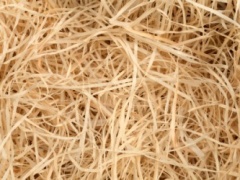Raffia
| Infobox on Raffia | |
|---|---|
| Example of Raffia |  |
| Facts | |
| Origin | - |
| Stowage factor (in m3/t) |
|
| Humidity / moisture | 12% |
| Ventilation | See text |
| Risk factors | See text |
Raffia
Description / Application
A large palm tree grows leaves that can be stripped and dried to create raffia strands. Like jute or hemp twine, this is a natural fiber that can be woven like straw, tied like silk ribbons, or packed like foam. Milliners, crafters, and florists enjoy using the grass-like material for a variety of projects and gifts.
The creamy-brown coloured lengths come from a specific palm tree that originally grew only on the island of Madagascar. Raphia farinifera actually has the largest leaves of any palm tree, so it is a logical source for fibre. The fibrous leaves are cut off and torn apart in parallel lines to yield very long strips of material. The tree is now cultivated specifically for harvest and export in East Africa, as well.
Crafters value raffia for being soft, durable, and easy to dye. It can take the place of cord, grass, leaves, fabric, ribbon, stuffing, floral string, and even paper. A wide variety of hats, mats, baskets, bags, and twine are made from this natural material. Often, it is invaluable to outdoor projects because it doesn't shrink with moisture, yet is pliable enough to weave.
Raffia fibres have many uses, especially in the area of textiles and in construction. In their local environments, they are used for ropes, sticks and supporting beams, and various roof coverings are made out of its fibrous branches and leaves. The membrane on the underside of each individual frond leaf is taken off to create a long thin fibre which can be dyed and woven as a textile into products ranging from hats to shoes to decorative mats. Plain raffia fibres are exported and used as garden ties or as a "natural" string in many countries. Especially when one wishes to graft trees, raffia is used to hold plant parts together as this natural rope has many benefits for this purpose.
Raffia palm also provides an important cultural drink. The sap contains sugars. It is traditionally collected by cutting a box in the top of the palm and suspending a large gourd to collect the milky white liquid. Unlike oil palms, this process kills the tree. Sap from both the raffia and oil palms can be allowed to ferment over a few days. When first collected from the tree, it is sweet and appears slightly carbonated. As it ages more sugar is converted. The sap is usually called wine. The raffia wine tends to be sweeter at any age when compared to oil palm wine. Both kinds of palm wine can also be distilled into strong liquors, such as Ogogoro. Traditionally in some cultures where raffia and/or oil palm are locally available, guests and spirits are offered these drinks from the palm trees.
Shipment / Storage
Raffia behaves strongly hygroscopically. It must be protected from sea, rain and condensation water and also from high levels of relative humidity, as otherwise the resultant mustiness, rot and mould may cause depreciation.
If the product is loaded for shipment in a dry state, it does not have any particular ventilation requirements.
Risk factors
- Self-heating / Spontaneous combustion ((Spontaneously combustible, Class 4.2 IMDG Code ; Fire hazard (Flammable solids), Class 4.1 IMDG Code))
- Odor
- Contamination
- Mechanical influences
- Shrinkage/Shortage











